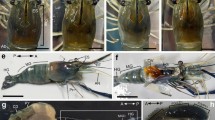Abstract
Coelenterazine biosynthesis has recently been demonstrated in the developing eggs of the decapod Systellaspis debilis. The cellular source of coelenterazine and the potential for biosynthesis in adult decapods, however, have not been fully investigated. We have conducted a systematic study of coelenterazine content in >230 individual decapods representing 19 species of Oplophoridae and 22 species from other families. We show for the first time that coelenterazine is responsible for both secretory and photophore luminescence in the same decapod. Tissues associated with secretory luminescence (hepatopancreas and stomach) in the Oplophoridae contained almost 3 orders of magnitude more coelenterazine (mean value=2154 pmol per specimen) than cuticular photophores (mean value=8 pmol per specimen). Coelenterazine content increases by 2 to 4 orders of magnitude during the development of three species of Oplophoridae. Species of Oplophoridae contain an order of magnitude more coelenterazine than those of other families (mean value=154 pmol per specimen). Coelenterazine was also detected in 11 apparently nonluminous decapod species (mean value=200 pmol per specimen). S. debilis luciferase characterisation enabled a luciferase assay to be developed to facilitate studies of the environmental control of bioluminescence. We hypothesise that the coelenterazine requirement in secretory bioluminescence exceeds that which could be assimilated from the food-chain. The significant increase of coelenterazine during the life cycle of secretory decapods supports this hypothesis. Putative evidence for environmental control of coelenterazine luminescence is also reported.
Similar content being viewed by others
References
Campbell AK (1988) Chemiluminescence: principles and applications in biology and medicine. VCH/Horwood, Chichester
Campbell AK, Herring PJ (1990) Imidazolopyrazine bioluminescence in copepods and other marine organisms. Mar Biol 104: 219–225
Chomczynski P, Sacchi N (1987) Single-step method of RNA isolation by acid guanidinium thiocyanate-phenol-chloroform extraction. Analyt Biochem 162: 156–159
Dixon M, Webb EC (1979) Enzymes. Academic Press, New York
Frank TM, Widder EA, Latz MI, Case JF (1984) Dietary maintenance of bioluminescence in a deep-sea mysid. J exp Biol 109: 385–389
Haddock SHD, Case JF (1994) A bioluminescent chaetognath. Nature, Lond 367: 225–226
Herring PJ (1976) Bioluminescence in decapod Crustacea. J mar biol Ass UK 56: 1029–1047
Herring PJ (1981) The comparative morphology of hepatic photophores in decapod Crustacea. J mar biol Ass UK 61: 723–737
Herring PJ (1983) The spectral characteristics of luminous marine organisms. Proc R Soc (Ser B) 220: 183–217
Herring PJ (1985) Bioluminescence in the Crustacea. J Crustacean Biol 5: 557–573
Inoue S, Kakoi H, Goto T (1976) Oplophorus luciferin, bioluminescent substance of the decapod shrimps Oplophorus spinosus and Heterocarpus laevigatus. J Chem Soc Chem Communs 1976: 1056–1057
Kendall JM, Badminton MN, Dormer RL, Campbell AK (1994) Changes in free calcium in the endoplasmic reticulum of living cells detected using targeted aequorin. Analyt Biochem 221: 173–181
Knight MR, Read ND, Campbell AK, Trewavas AJ (1993) Imaging calcium dynamics in living plants using semi-synthetic recombinant aequorins. J Cell Biol 121: 83–90
Latz MI, Bowlby MR, Case JF (1990) Recovery and stimulation of copepod bioluminescence. J exp mar Biol Ecol 136: 1–22
Latz MI, Case JF (1992) Slow photic and chemical induction of bioluminescence in the midwater shrimp, Sergestes similis Hansen. Biol Bull mar biol Lab, Woods Hole 182: 391–400
Latz MI, Frank TM, Case JF (1988) Spectral composition of bioluminescence of epipelagic organisms from the Sargasso Sea. Mar Biol 98: 441–446
McCapra F (1990) The chemistry of bioluminescence: origins and mechanism. In: Herring PJ, Campbell AK, Whitfield M, Maddock L (eds) Light and life in the sea. Cambridge University Press, Cambridge, pp 265–278
Michelson AM (1978) Purification and properties of Pholas dactylus luciferin and luciferase. Meth Enzym 57: 385–406
Roe HSJ (1984) Vertical migrations and feeding of mysids and decapod Crustacea. Prog Oceanogr 13: 269–318
Shimomura O (1987) Presence of coelenterazine in nonbioluminescent marine organisms. Comp Biochem Physiol 86B: 361–363
Shimomura O, Inoue S, Johnson FH, Haneda Y (1980) Widespread occurrence of coelenterazine in marine bioluminescence. Comp Biochem Physiol 65B: 435–437
Shimomura O, Masugi T, Johnson FH, Haneda Y (1978) Properties and reaction mechanism of the bioluminescence system of the deep-sea shrimp Oplophorus gracilorostris. Biochemistry (Am Chem Soc) Easton, Pa 17: 994–998
Thompson EM, Nafpaktitis BG, Tsuji FI (1988) Dietary uptake and blood transport of Vargula (crustacean) luciferin in the bioluminescent fish, Porichthys notatus. Comp Biochem Physiol 89A: 203–209
Thomson CM, Herring PJ, Campbell AK (1995) Evidence for de novo biosynthesis of coelenterazine in the bioluminescent midwater shrimp, Systellaspis debilis. J mar biol Ass UK 75: 165–171
Viviani VR, Bechara EJH (1993) Biophysical and biochemical aspects of phengodid (railroad-worm) bioluminescence. Photochem Photobiol 58: 615–622
Ward WW, Davis DF, Cutler MW (1994) The origin of chromophores in coelenterate bioluminescence. In: Campbell AK, Kricka LJ, Stanley PE (eds) Bioluminescence and chemiluminescence: fundamentals and applied aspects, John Wiley, Chichester, pp 131–134
Watkins NJ, Herring PJ, Campbell AK (1993) An evolutionary pathway for acquorin and coelenterazine bioluminescence. In: Szalay AA, Kricka LJ, Stanley PE (eds) Bioluminesence and chemiluminesence: status report. John Wiley, Chichester, pp 64–68
Widder EA, Latz MI, Case JF (1983) Marine bioluminescence spectra measured with an optical multichannel detection system. Biol Bull mar biol Lab, Woods Hole 165: 791–810
Wood KV, Lam YA, Seliger HH, McElroy WD (1989) Complementary DNA coding click beetle luciferases can elicit bioluminescence of different colors. Science, NY 244: 700–702
Author information
Authors and Affiliations
Additional information
Communicated by J. Mauchline, Oban
Rights and permissions
About this article
Cite this article
Thomson, C.M., Herring, P.J. & Campbell, A.K. Coelenterazine distribution and luciferase characteristics in oceanic decapod crustaceans. Marine Biology 124, 197–207 (1995). https://doi.org/10.1007/BF00347123
Received:
Accepted:
Issue Date:
DOI: https://doi.org/10.1007/BF00347123




